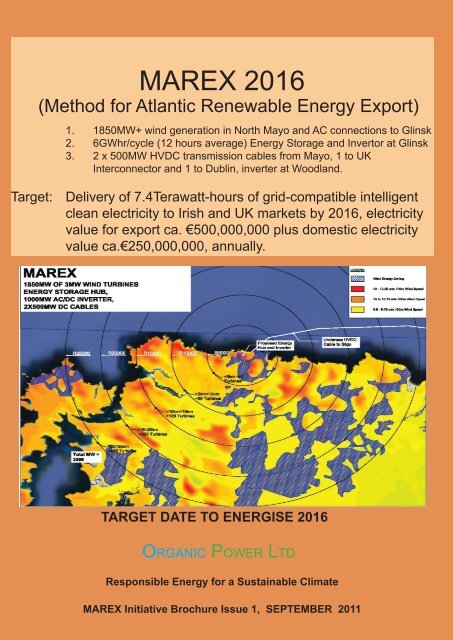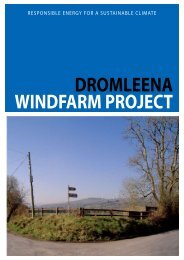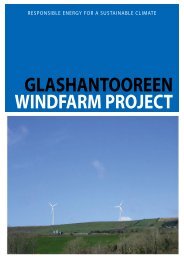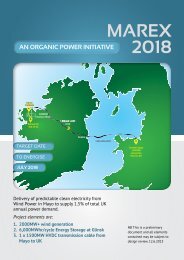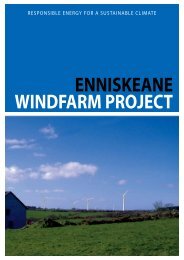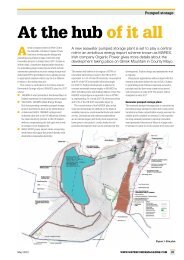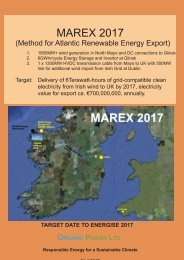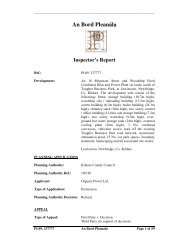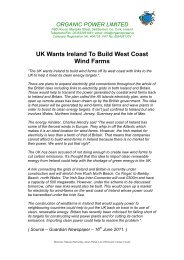MAREX 2016 - Organic Power
MAREX 2016 - Organic Power
MAREX 2016 - Organic Power
Create successful ePaper yourself
Turn your PDF publications into a flip-book with our unique Google optimized e-Paper software.
<strong>MAREX</strong> <strong>2016</strong><br />
(Method for Atlantic Renewable Energy Export)<br />
1. 1850MW+ wind generation in North Mayo and AC connections to Glinsk<br />
2. 6GWhr/cycle (12 hours average) Energy Storage and Invertor at Glinsk<br />
3. 2 x 500MW HVDC transmission cables from Mayo, 1 to UK<br />
Interconnector and 1 to Dublin, inverter at Woodland.<br />
Target: Delivery of 7.4Terawatt-hours of grid-compatible intelligent<br />
clean electricity to Irish and UK markets by <strong>2016</strong>, electricity<br />
value for export ca. €500,000,000 plus domestic electricity<br />
value ca.€250,000,000, annually.<br />
TARGET DATE TO ENERGISE <strong>2016</strong><br />
<strong>Organic</strong> <strong>Power</strong> Ltd<br />
Responsible Energy for a Sustainable Climate<br />
<strong>MAREX</strong> Initiative Brochure Issue 1, SEPTEMBER 2011
What is the initiative?<br />
CLEAN ENERGY INFRASTRUCTURE<br />
The initiative is proposed by <strong>Organic</strong> <strong>Power</strong> to provide infrastructure to export large volumes of intelligent clean energy<br />
from Mayo to both the Greater Dublin Area and the UK by <strong>2016</strong>. We believe if all stakeholders engage with the initiative,<br />
there are no technical or environmental barriers to its completion in a short timeframe. It is composed of 3 elements:<br />
A large scale large turbine wind farm<br />
Wind in North Mayo<br />
The Mayo County Council Renewable<br />
Energy Strategy adopted in<br />
2011 has zoned an enormous area<br />
of land as suitable for wind development<br />
and a further area open to<br />
consideration, which is sufficient<br />
to accomodate many thousands of<br />
Megawatts (MW) of Windpower capacity,<br />
in large windfarms, in a part of<br />
the country where large size windmill<br />
efficiency will exceed 50% due the<br />
high energy wind resource available.<br />
This compares very favourably with<br />
the other large zoned areas in midland<br />
counties where efficiency will<br />
be 40% or less. Therefore investing<br />
in wind turbines in North Mayo will<br />
generate a superior return on investment<br />
than in the midlands. There is<br />
zoned potential for 129MW of wind<br />
within 5km of Glinsk, 207MW between<br />
5 and 10km, 387MW between<br />
10 and 15km, 909MW between 15<br />
and 20km, 1464MW between 20<br />
and 25km of the Energy Storage<br />
Hub. This is on the basis of 3MW<br />
machines spaced 500m apart. It is<br />
probable that 6MW offshore type turbines<br />
may be suitable for this area,<br />
increasing the potential wind capacity<br />
considerably. Wind farms would<br />
be connected using underground AC<br />
cables to an AC/DC node adjacent<br />
to the Energy Storage Hub. When<br />
wind generation is above 50% capacity<br />
(1000MW) the excess will be<br />
diverted into the energy storage at<br />
Glinsk for delivery when the wind<br />
drops wind farm output below 50%.<br />
Proposed Seawater PHES at Glinsk<br />
Energy Storage<br />
The Glinsk Energy Storage Hub will<br />
accept up to 960MW of power from<br />
the windfarms for storage. This<br />
power will be held in storage until<br />
peak demand periods occur during<br />
any given day and then exported<br />
to coincide with demand. It will add<br />
value to the variable electricity produced<br />
by the wind generators, and<br />
provide a large scale intelligent energy<br />
source.<br />
It will be ready to also accept wave<br />
energy at large scale when this<br />
technology comes of age.<br />
It will link the best wind resource in<br />
Europe to the UK market, delivering<br />
power intelligently when needed.<br />
The PHES will be at least 78% efficient<br />
overall.<br />
The PHES scheme can deliver intelligent<br />
power at maximum output<br />
for 6 hours per day (or much longer<br />
at reduced output), corresponding<br />
to peak demand on the day in the<br />
UK and Ireland. The scheme will<br />
accept energy off peak for 4 up to<br />
20 hours per day depending on the<br />
available wind energy.<br />
The diversion of windpower above<br />
1000MW output into storage ensures<br />
maximum utility for the wind<br />
farms and permits 2000MW of wind<br />
to be connected to market using<br />
1000MW of transmission cable.<br />
Example Bipole HVDC cable<br />
HVDC transmission<br />
The main obstacle to developing<br />
this clean intelligent energy resource<br />
is the lack of transmission<br />
infrastructure to export the power<br />
from Mayo to market. EIRGRID<br />
has plans to build a single 400kV<br />
line to the area by 2019, which<br />
will at very best, only accomodate<br />
1500MW of wind power.<br />
The proposal to link intelligent<br />
energy to the market therefore includes<br />
a dedicated transmission<br />
system to deliver power to suitable<br />
markets, in Dublin and the UK.<br />
This transmission system will be<br />
composed of 2 part -undersea and<br />
part-underground cables each capable<br />
of transmitting 500MW as a<br />
minimum. One cable will deliver<br />
power for distribution in the Dublin<br />
Area, and the other will be linked<br />
to the UK interconnector to export<br />
500MW of power to the UK, or intelligently<br />
import nuclear power for<br />
storage for storage in times of long<br />
calm weather periods.<br />
HVDC is appropriate technology<br />
for this application because it is<br />
suitable for undersea and underground,<br />
avoiding the public conflicts<br />
generated by overhead lines.<br />
It will also allow the efficient transmission<br />
power at low levels of<br />
losses accross the country.<br />
<strong>Organic</strong> <strong>Power</strong> Ltd
BENEFITS OF <strong>MAREX</strong> INITIATIVE<br />
• 1000MW of clean energy can be sustainably<br />
exported from an area where the wind<br />
resource is high, population density is low,<br />
there is little employment,and sufficient<br />
land has been zoned for the purpose. This<br />
will generate export revenue in the order of<br />
€500,000,000 per year once installed.<br />
• The avoidance of displaced gas generation<br />
CO2 emissions will total at least 4.6 million<br />
tonnes annually.<br />
• Over a short time frame it will unlock the<br />
potential to install over 600 large wind turbines<br />
(1850MW) of planned wind farms in<br />
North Mayo which will be among the most<br />
efficient onshore wind farms in Europe due<br />
to the wind resource available.<br />
• This level of windfarm construction will allow<br />
the manufacture of 3MW or even 5MW<br />
wind turbines to be undertaken locally, creating<br />
at least 500 jobs and €3 billion investment<br />
over a 5 year window.<br />
• The energy storage hub will create 200 jobs<br />
and €0.5 billion investment over a 3 year<br />
window.<br />
• The energy storage hub will accept<br />
6000MWhrs of electricity from the wind<br />
farms, the equivalent of 12 hours output<br />
at average production of the wind turbines,<br />
during times when demand is low (night<br />
time), transforming clean but unpredictable<br />
energy from local windfarms and ocean energy<br />
projects, into a high quality predictable<br />
intelligent green electricity product by storing<br />
it for use when needed.<br />
• The efficient use energy storage hub will<br />
provide a user for water pumped by up to<br />
1000 MW of wave pumps, when this technology<br />
becomes mature.<br />
• The initiative will, in its own right, justify<br />
the installation of a dedicated High Voltage<br />
Grid connection to North Mayo from the<br />
East-West interconnector for the export of<br />
renewable energy to the UK.<br />
Input electricity will be sourced from grid connected wind and wave energy projects. The<br />
process will transform unpredictable and variable wind and wave power to reliable, dispatchable<br />
power delivered to the markets that need it via undeground cables.<br />
<strong>Organic</strong> <strong>Power</strong> Ltd
HVDC TRANSMISSION OVERVIEW<br />
WHY HVDC?<br />
The resource that this initiative wishes to<br />
harness and condition, via wind energy<br />
convertors and energy storage, is geographically<br />
removed from the identified<br />
markets for electricity (the greater Dublin<br />
area and the UK). Woodland is the ideal<br />
location for a connection to both markets.<br />
The problem is how to get the power there.<br />
Overhead power lines are the object of<br />
much public opposition as they are percieved<br />
by many to be visually obtrusive<br />
and some people have concerns regarding<br />
potential risks from electromagnetic<br />
radiation (whether real or imagined).<br />
To allay these concerns, the use of DC<br />
gives 2 distinct advantages, firstly, due<br />
to a much reduced heat loss in DC cables,<br />
they can be buried undersea and<br />
underground without cooling systems<br />
at high voltages, and secondly, electromagnetic<br />
radiation is also much reduced.<br />
Bipolar 700MW Cable used for Norned<br />
THE CABLE<br />
At this preliminary stage, it is very difficult<br />
to describe with any certainty, the actual<br />
specifications of the cable that will be used.<br />
However, given the distances involved<br />
and the obvious benefits of redundancy in<br />
the system, 2 bipolar cables with a high<br />
power rating would appear to be a promising<br />
option. 800MW rated bipolar cables<br />
are commercially available and may be<br />
suitable for the <strong>MAREX</strong> proposal operated<br />
using Voltage source Commutation <strong>Power</strong><br />
control. This would allow each cable to be<br />
operated at 500MW initially with the potential<br />
for increasing the power carried later.<br />
EIRGRID may operate a 600MW connection<br />
cap to the national grid, and<br />
this may constrain the potential power<br />
to be carried by the cable proposed to<br />
connect to the EIRGRID AC system<br />
at Woodland. The rated capacity of<br />
the existing HVDC interconnector to<br />
the UK is 500MW and this limits the<br />
power that can be connected to that.<br />
The advantages of the VSC bipolar<br />
HVDC configuration are:<br />
• Undersea cables, where<br />
high capacitance causes<br />
additional AC losses.<br />
• Endpoint-to-endpoint longhaul<br />
bulk power transmission<br />
without intermediate ‘taps’,<br />
for example, in remote areas.<br />
• Increasing the capacity of an<br />
existing power grid in situations<br />
where additional wires are<br />
difficult or expensive to install<br />
• <strong>Power</strong> transmission and stabilization<br />
between unsynchronised<br />
AC distribution systems<br />
• Connecting a remote generating<br />
plant to the distribution grid,<br />
• Stabilizing a predominantly AC<br />
power-grid, without increasing<br />
prospective short circuit current<br />
• Reducing line cost. HVDC<br />
needs fewer thinner conductors<br />
as there is no need<br />
to support multiple phases.<br />
• Synchronize AC produced by<br />
renewable energy sources<br />
• VSC technology provides a<br />
straight forward AC side connection.<br />
The modular multilevel<br />
converter principle renders AC<br />
harmonic filters superfluous.<br />
• A standard transformer design<br />
can be used without special requirements<br />
to withstand DC<br />
voltage or harmonic currents.<br />
• Converters do not produce<br />
any significant high frequency<br />
noise, so outdoor installation of<br />
AC- and DC reactors (if necessary)<br />
and switchgear is feasible.<br />
CABLE INSERTION<br />
At an initial level of examination it is<br />
expected that the cable route from<br />
Glinsk to Woodland will have the following<br />
insertion methods:<br />
• 2 no. 500MW Outdoor convertor<br />
at Glinsk<br />
• 500m Cross shore horizontal directional<br />
drilling section in tunnelled<br />
cable duct.<br />
• 65km approx. smartjet subsea<br />
insertion 2m below sandy substrate.<br />
• 5km approx sand plough insertion<br />
1.2m deep across intertidal<br />
shore Sligo Bay to pier head.<br />
• 1.5km approx. Under road<br />
trench to rail head.<br />
• Verge trench 1.2m deep alongside<br />
permanent way 190km<br />
• Surface trough insertion accross<br />
bridges and through stations.<br />
• Horizontal directional drillingwhere<br />
exceptionally required<br />
in narrow sections of available<br />
wayleave along permanent<br />
way.<br />
• Under Road trench 1.2m deep<br />
from permanent way to Woodland<br />
substation.<br />
• 2 no. 500MW convertors at<br />
Woodland<br />
CABLE COSTS<br />
At this preliminary stage costs are<br />
hard to estimate, however, ballpark<br />
indication from extrapolation,<br />
allows an estimate in the region<br />
of €300,000,000 to be suggested.<br />
This would be paid for in principle<br />
by connection charges, and use<br />
of system charges would cover<br />
running cost. A combined capacity<br />
connection for <strong>MAREX</strong> would<br />
comprise around 2810MW, indicating<br />
a connection charge of approx.<br />
€100,000-120,000/MW.<br />
<strong>Organic</strong> <strong>Power</strong> Ltd
CABLE INSERTION SYSTEMS<br />
Example of an AC/HVDC convertor installation<br />
Schematic of Smart jet subsea cable burial vehicle<br />
Example of an intake structure<br />
Cable insertion using Horizontal directional drilling<br />
Example of sand plough cable insertion<br />
Example of subsea cable laying vessel<br />
Example of trench insertion HVDC cables<br />
Smart jet cable burial vehicle<br />
Example of Wayleave verge cable insertion<br />
<strong>Organic</strong> <strong>Power</strong> Ltd
8<br />
<strong>Organic</strong> <strong>Power</strong> Ltd
<strong>Organic</strong> <strong>Power</strong> Ltd<br />
9
Description Unit Data<br />
WIND GENERATION<br />
Location<br />
Erris, Mayo<br />
Capacity zoned within 25km MW 3000MW approx.<br />
Predicted wind at 100m+ height m/s 10<br />
Capacity factor expected % 52<br />
Required optimum capacity MW 1850<br />
Number of turbines if 3MW rated - 615<br />
class 1, 1A Type<br />
Hub Height m 130+<br />
Turbine separation 360 degrees m 500<br />
Connection to Glinsk kV 110/220 AC XLPE<br />
underground or similar<br />
Projected annual power production TWhr 8.3<br />
ENERGY STORAGE HUB<br />
Operating head m 295.5<br />
Reservoir volume m3 8,900,000<br />
Energy storage capacity<br />
MWhr 6,000/cycle<br />
Minimum drawdown, fill rate hours 6,7<br />
Rated capacity MW 960<br />
Projected annual power storage TWhr 3.25<br />
HVDC TRANSMISSION<br />
Cable Type - Bipole, buried<br />
From location (1,2) - Glinsk, Mayo<br />
To location (1) - AC system Woodland<br />
To location (2) - DC interconnector, Woodland<br />
Cable length km 270 approx<br />
Commutation - Voltage Sourced<br />
Maximum cable power (certified) MW 550<br />
Maximum output combined cables MW 1100<br />
Projected average power MW 1000 for 7400 hours/year<br />
<strong>Organic</strong> <strong>Power</strong> Ltd<br />
Issued September 2011<br />
FBD House, Mardyke Street, Skibbereen,<br />
County Cork, Ireland<br />
Tel: +353 (0)28 51951<br />
E-mail: info@organicpower.ie<br />
Web : www.organicpower.ie


